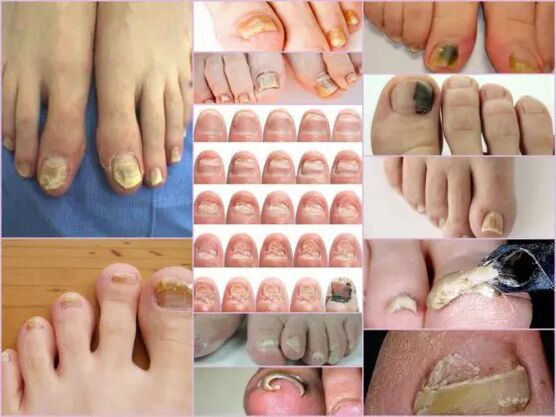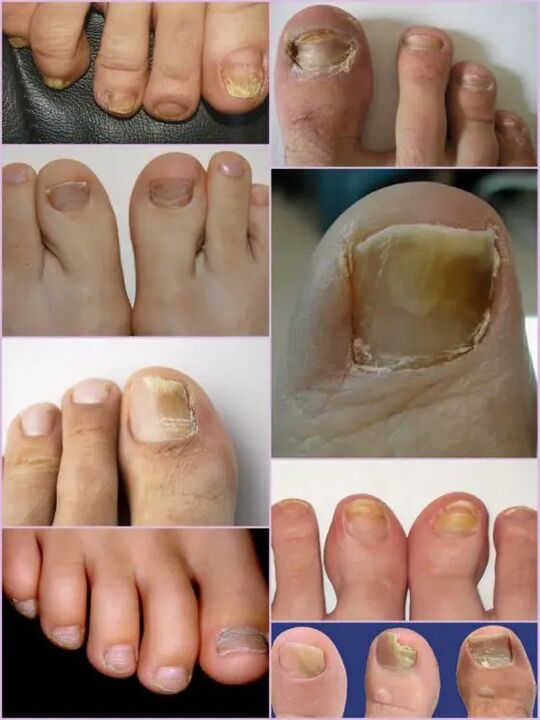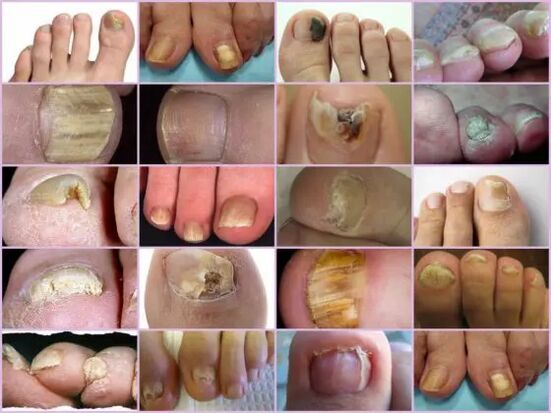
Onychomycosis is a type of fungal lesion that exclusively affects the surface of the nail.To avoid the dissemination of time infection, you should know what nail fungus is like, as the therapeutic effect will be reached faster if treatment begins at an early stage of the infection.Most of the time, the disease occurs in the elderly due to poor immunity, but the risk of obtaining a disease concerns all people.There is no unique classification of damage caused by fungal nails;In medical practice, it is customary to distinguish them in the place of location and at the depth they penetrate.The infection is also grouped, depending on the type of pathogen.
Types of pathogens and primary signs
The symptoms of nail fungus at the early stage are easily determined directly by nail condition.This signal is the most informative, since onychomycosis always manifests itself in the form of changes in surface color, bed deformation, exfoliation and any external changes.The latter are expressed by the roughness, the formation of grooves and cracks, as well as the interspersed violation and the overall violation of the nail.
The main sign of a healthy nail is pink and transparency.Onychomycosis at any stage is characterized by nail turbidity and color change to yellow, brownish or greenish black.At an advanced stage, the surface can acquire a black shadow against the bottom of almost complete destruction.
External signs of fungal infection depend on the type of pathogen it has infected.In medical practice, the following possible lesions are distinguished:
- Candida infection with a fungus, which is expressed by the nail discharge directly at the base of the box.Candidiasis of the rolls around the nail will be characteristic of candidiasis.This version of the complication may have a bacterial source in the form of streptococci or staphylococci, or expressed in the form of medium or psoriasis plates;
- Trichophyton rubrum dermatophytes.In this case, the penetration of the infection occurs directly from the free edge of the nail.The first symptoms of such a pathogen are the appearance of a yellowish point on the surface.In the field of neoplasia, nails collapse and the point itself tends to increase.The common location location place of neoplasia is along the plate, parallel to the nail rollers, in this case the infection is called distal-lateral.There is another form of defeat by this distal pathogen, in which the point appears in the part removed from the hole, especially in the middle of the free edge;
Important!
This type of fungus occurs more often in the thumbs of the legs, gradually turning the nails into a loose yellowish dough.In the absence of proper treatment, disease flows to hyperkeratosis.The nail plate is completely destroyed due to the spread of the infection around the perimeter.
- Dermatophytes like Trichophyton Mentagrophytes.Onychomycosis with these exciters is also usually based on thumb nails, less often than small fingers.Such a fungus infection requires therapy not only from the nail but also from the feet due to the rapid spread of the pathogen.A symptomatic disease can be like Leikonichia, a common disease in medical practice.Primary signs are white spots that appear in various parts of the nail, neoplasms are distinguished by a non -standard form and various sizes.It is easy to distinguish Leakonichia's fungus - in the latter case, the points are an air accumulation, which is not observed with fungal damage;
- Mold fungus.This damage option is found significantly less often than a candidate or dermatophytic shape.The main sign of such infection - the plate surface acquires a dark black tone.Not even the whole finger can be completely infected, but only part of the nail plate.The first signs of nail fungus on the legs of this type are a sharp change in color.Onychomycosis can develop in the form of a dark black or dark green track against the bottom of the pink part of the nail.
Diagnosis by type of change
It is not difficult to notice a nail fungus on the legs, even in the primary stages of infection, since such an infection manifests itself quite actively from the first day of the injury.Instead of the usual transparent nails of pale pink in the patient, significant surface deformation and a general change in condition are observed.The affected area has a dull yellowish hue, which appears mainly in the thumbs.The type of fungus and the degree of damage are determining factors.
In the first stage, fungal damage to the legs on the legs is the appearance of small focuses.The thickening of the plate and the keratinization of the bed under the nail will be characteristic.This stage is accompanied by a phenomenon such as partial detachment and nail plate discharge, which serves as a source of infection for healthy people.

Despite the active thickening of the plate, its constant rectification can be observed, regardless of current factors.The characteristics of each stage and symptoms of the fungus on the legs depend directly on the pathogen type.
Depending on the changes that occur with the nail plate, three options of onychomycosis are distinguished:
- Hypertrophic;
- Normotrophic;
- Atrophic.
In the first case, there is a sharp change in the shadow of the nail plate, its destruction along the edges, as well as deformation of the plate surface.The nail thickens so much that it causes discomfort and painful sensations when walking.Normotrophic ringworm of nails on the legs is distinguished by the presence of a healthy glow, but the sign itself acquires something yellowish, the spots are formed in it.With a type of atrophic damage, brown foci and gray on the surface of the nails.Thanks to them, it is possible to precisely determine the location of the pathogen.
Important!
The atrophic or onicolithic type fungus of nail fungus is characterized by the tuning of the nail plate, not by its growth, as in other cases.The areas in which the pathogen is located tend to stand out.Lack of proper treatment leads to an advanced stage - the complete rejection of the nail plate.
Location classification
Another sign by which you can separate fungal damage to your toe nails depends directly on the location of the focus on the nail plate.This also includes the depth of the pathogen, which in turn allows to determine the approximate duration of the next therapy and the chances of a rapid recovery.
The fungal diseases of leg nails at the location site are classified in the following groups:
- Onychomycosis is a type of white surface - the appearance of many whitish points on the surface of the nail plate.A fungal infection leads to the detachment of the skin in the point -of -point places where there is an active scales discharge.The advanced stage leads to complete destruction and rejection of the plate;
- Distal - develops on the free edge of the nail.Color change is first observed in a small area of the plate, after which there is an active expansion of its limits.The lesion is characterized by a yellowish or brown gray shade, as well as an irregular surface and gradual exfoliation;
- Lateral onychomycosis has the stages of development similar to distal, but is located exclusively on the sides of the nail plate;
- Total infection - complete infection of the entire surface;
- Proximal onychomycosis.This disease begins its inflamed cuticle activity, so the fungus quickly affects the nail, and the process itself begins with the appearance of a small white spot near the inflamed area of the perioloso roll.

The most common forms of nail ringworm in the legs are lateral and distal, which is usually caused by dermatophytes.Such forms of damage as proximal and white can act as a secondary disease that accompanies immune disease disease, for example, Vich.Total nail damage with a fungus should be considered an advanced stage of developing any fungus under nail.
Fungus resources under the microscope
Despite the presence of an impressive number of signs of onychomycosis, other diseases associated with skin problems and not infectious in nature are accepted by fungal damage to the nails of the legs.You can determine the exact diagnosis and the type of pathogen only in the laboratory under a microscope, for which, in a hospital, a scraping of biological material from the affected areas is performed.
The resulting biomaterial is pre -clocked in an alkaline environment, after which a multiple increase is performed.The study of nail fungus under a microscope allows you to see an active pathogen whose external form determines its type, distribution scale and an approximate degree of damage.In a nutrient environment, you can predict the approximate growth of the colonies, which allows not only a precise diagnosis but also to determine the limitation of the infection.
Important!
As it is possible to determine the presence of onychomycosis only in one laboratory, you should not postpone a visit to the doctor in the slightest suspicion.Nail fungus develops rapidly and waste of time increases therapy.
What is an alarming signal?
Nail fungus on the legs manifests itself by certain symptoms partially similar to some skin diseases.The following signs are more likely to indicate an onicomic lesion that requires medical intervention:
- The appearance of yellow spots on the plate, its deformation, a change in the structure, which was not previously observed;
- The darkening of the plate, the loss of transparency, some photos of the nail fungus on the legs demonstrate a tone near black, which is characteristic of pathogen molds;
- Thickening and keratinization of the nail plate, or very clear thinning very clear;
- Rejection of the nail from the bed, detachment of scales and crumbs;
- Swelling of the roll, hanging above the plate, liquid release;
- The nails affected by the fungus seem inflamed, regardless of the type of pathogen.
All these symptoms indicate a high risk of infection.Some external symptoms to change the structure of the nail plate may be the result of other diseases.With increasing fragility, the amount of calcium and iron in the body should be increased, increased tuberosity means any body infection, with purely white strips and points, a lack of copper or zinc is possible.Despite the fact that, in the photo, nail fungus looks like focal damage to the plate with a color change closer to yellow, this does not always indicate the infection.Yellowness can indicate various problems with the stomach and liver.
It is not difficult to recognize onychomycosis on the fingers by external signs, despite the extensive classification of the disease.But you can determine the exact type of the pathogen and the damage stage can only be in the laboratory.


















